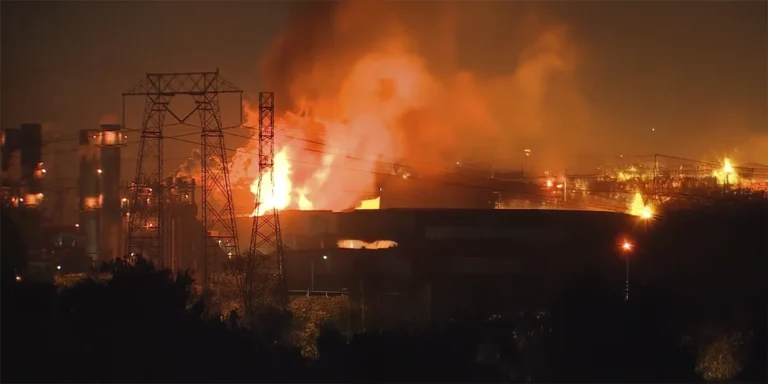Moss Landing Fire: Shocking New Details Revealed 2025

Table of Contents
1. Introduction
The Moss Landing fire has captured national attention due to its alarming consequences and implications for energy storage safety. The January 2025 fire at the Moss Landing Power Plant highlighted the risks associated with large-scale lithium-ion battery storage, sparking concerns among environmentalists and local residents. This article delves into the shocking new details surrounding the incident, including its causes, legal implications, and future impact
2. Background of Moss Landing Power Plant
2.1 History and Significance
Located in Monterey County, California, the Moss Landing Power Plant has been a major energy hub for decades. Initially a natural gas-powered facility, it played a crucial role in powering California’s electricity grid before undergoing significant transformation.
2.2 Transition to Battery Energy Storage
To support California’s clean energy goals, the facility was converted into one of the largest battery energy storage systems (BESS) in the world. Managed by Vistra Corp, the BESS was designed to store renewable energy for use during peak demand periods. However, this transition has not been without its challenges.
3. The January 2025 Moss Landing Fire Incident
3.1 Timeline of Events
On January 16, 2025, a Moss Landing fire broke out in the 300MW Phase 1 building of the facility. The fire, fueled by lithium-ion batteries, quickly escalated. Despite fire suppression efforts, the blaze continued burning for hours, raising concerns about toxic smoke and environmental hazards.
3.2 Immediate Response and Evacuations
In response, authorities evacuated approximately 1,200 residents, warning them to stay indoors to avoid exposure to potentially harmful fumes. Firefighters monitored the fire closely, allowing it to burn out naturally due to the complexities of lithium-ion battery fires.
4. Environmental Impact
4.1 Air Quality Concerns
The Moss Landing fire caused widespread air pollution concerns. While initial tests showed no immediate toxic threats, officials advised residents to keep doors and windows closed as a precaution.
4.2 Contamination of Elkhorn Slough
Researchers found that the fire had released heavy metals, such as nickel, cobalt, and manganese, into Elkhorn Slough, an important ecological site. These contaminants were detected at levels far higher than usual, raising alarms about potential long-term environmental damage.
5. Reignition and Ongoing Challenges
5.1 February 2025 Reignition
Just weeks after the initial incident, a secondary Moss Landing fire reignited on February 19, 2025. Though less severe, this event reinforced concerns about the facility’s safety protocols.
5.2 Community Safety Measures
Local officials continued to urge residents to take precautions, including staying indoors during periods of high smoke concentration. Schools and businesses near the facility implemented additional safety measures.
6. Legal Actions and Accountability
6.1 Lawsuits Against Vistra and PG&E
Following the fires, lawsuits were filed against Vistra Corp and PG&E, accusing them of negligence in maintaining the facility and failing to implement adequate safety measures.
6.2 Role of Environmental Activists
High-profile activists, including Erin Brockovich, have joined the fight, pushing for stricter safety regulations and greater accountability from energy companies
7. Implications for Energy Storage Industry
7.1 Safety of Lithium-Ion Batteries
The Moss Landing fire has reignited debates over the safety of lithium-ion batteries, particularly those using nickel manganese cobalt (NMC) chemistry, which is more prone to overheating.
7.2 Future of Large-Scale Energy Storage
Experts are calling for new fire suppression technologies and alternative battery chemistries, such as lithium iron phosphate (LFP), to reduce fire risks in energy storage facilities.
8. Conclusion
The Moss Landing fire serves as a wake-up call for the energy storage industry. While battery storage is crucial for renewable energy integration, safety concerns must be addressed. With ongoing legal battles, environmental fallout, and renewed regulatory scrutiny, the future of large-scale energy storage depends on lessons learned from this incident. As the community awaits further updates, the Moss Landing fire update remains a topic of concern for residents and policymakers alike
9. FAQs
1. What caused the Moss Landing fire?
The fire was caused by overheating lithium-ion batteries in the energy storage facility, leading to thermal runaway and ignition.
2. Was anyone injured in the Moss Landing fire?
No injuries were reported, but over 1,200 residents were evacuated due to potential health risks from toxic smoke.
3. What are the environmental consequences of the Moss Landing fire?
The fire released heavy metals into the surrounding ecosystem, contaminating Elkhorn Slough and raising air quality concerns.
4. Has the Moss Landing fire reignited since the initial incident?
Yes, a secondary fire occurred in February 2025 due to smoldering lithium-ion batteries, reinforcing safety concerns.
5. How does the Moss Landing fire impact the future of battery storage?
The incident has prompted discussions about safer battery chemistries and stricter safety regulations for energy storage facilities.
